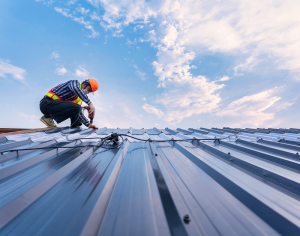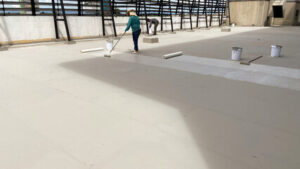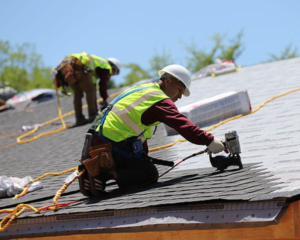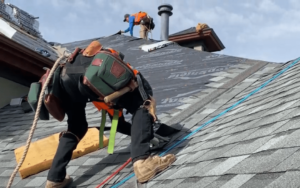Over time, all roofs start to show their age. When the roof starts to deteriorate it can leak, attract unwelcome wildlife and develop harmful mould growth that will have a major impact on your health.
Roof Restoration is a much less expensive alternative to roof replacement and is far less invasive for building occupants. It also helps reduce the environmental footprint as little to no materials are thrown away as in a full roof replacement.

During the restoration process, the existing roof is carefully inspected and any issues identified are repaired. Then a protective coating is applied to stop future damage and maintain the life of the roof. This treatment can extend the life of a metal, tile or asphalt roof by up to 25 years.
Before any work is carried out on your roof, the installer will test the surface to make sure that it is suitable for the application of a coating. The test will involve applying the treatment to a small patch of the roof and leaving it for a few days. The roof should be inspected after this period to ensure that the treatment has been successful and no further issues have arisen.
This is a great way to find out whether your roof is in good condition for a protective coating. It will also indicate if any further repairs or maintenance is required. Ideally, the roof should be restored well before any issues become apparent to maximise its useful life.
A sturdy roof provides the first line of defense against harsh weather elements such as rain, snow and strong UV rays. It also protects the inhabitants of a building from mold, mildew and poor ventilation that can lead to structural support issues and serious health problems. When the elements cause damage to a roof, it’s important to have a team of professional roofers that can provide timely repairs and keep the building safe from water infiltration and other harmful substances.
Roofing is a hard job that requires plenty of strength and stamina. It involves carrying heavy materials and working up high on ladders in all kinds of weather conditions. The work can be dangerous, especially if safety protocols are not followed correctly. Luckily, there are strict safety protocols and training that every contractor must go through before starting work on a project.
Aside from fire-resistant shingles, there are other layers that can be installed in order to protect the roof against various weather conditions. Among these are underlayment, which is a waterproof membrane that prevents leaks and water infiltration even if the shingle layer suffers damage. It is typically laid over plywood sheathing to prevent water from damaging the structure of the house.
Aesthetics
Aesthetic roof design is a fascinating and integral part of architecture that enhances the appearance, conveys architectural character, and harmonizes with the surrounding environment. It is also an important factor in boosting a building’s curb appeal and contributing to its overall value. The aesthetic of a roof is determined by a number of factors, including shape, materials, color, and texture.
Roofing is more than just a protective shield against the elements; it’s a canvas waiting to be painted! Whether it’s the sleek lines of a modern home, or the rustic charm of a charming cottage, a beautiful roof is what makes a house a home. When it comes to enhancing the visual appeal of your property, roofing is one of the most significant investments you can make.
The style and material of a roof are the most important factors in its aesthetics, as they have a powerful impact on the overall look of your property. Choosing the right roof materials will ensure that the colors and textures of your roof complement your building’s architectural style and create a harmonious balance. The pitch, or slope, of a roof also plays a major role in its aesthetic impression. A steeper roof evokes a sense of drama, while shallower pitches offer a more contemporary and streamlined appearance.
Aside from their aesthetic qualities, roofing materials are often chosen to satisfy specific performance and environmental requirements. For example, asphalt shingles are popular because of their durability and range of color options. They can be used to match any architectural style, from traditional gable roofs to contemporary flat roofs. Eco-friendly options like metal roofs with reflective surfaces and green roofs are becoming increasingly popular, as they help to reduce energy costs while contributing to a more sustainable environment.
Beyond boosting a building’s curb appeal, aesthetic roof design can also carry cultural and historical significance. For example, thatched roofs are still used in some rural areas, where they convey a connection with traditional building practices and promote sustainability.
Maintenance
A roofing system needs to be maintained and inspected regularly to ensure it performs as intended. Routine maintenance enables problems to be identified and repaired before they become serious. It also reduces the cost of repairing damage.
Generally, roof inspections should be performed by trained roofing professionals on a regular basis. Ideally, these inspections should be done on a biannual basis. However, if the roof is in an area that experiences extreme weather conditions or has structural components that are susceptible to damage, it may be beneficial to schedule these inspections more often.
The most basic maintenance procedure involves removing all debris from the rooftop. This includes dirt, gravel, leaves, twigs, and other organic material that can retain moisture and cause deterioration of the roofing surface. In addition, debris can clog drains and result in localized ponding of water on the roof that can damage the surface or underlying structures.
Other common roofing issues that need to be addressed include missing or damaged shingles; curled, torn, or ripped shingle edges; loose granules; and clogged gutters. The roofing structure also needs to be inspected to look for structural damage like sagging or buckling, deteriorated flashing (the material that is placed around chimneys and where the different roofing planes meet), and leaks.
Since these procedures require the facility staff to go on the roof, safety is another issue that must be considered. A professional roofing company can provide safe access equipment and safety training to employees to make the job less strenuous. Additionally, the company can inspect the condition of stairs, crossovers, platforms, and railings to ensure they are safe for rooftop work. Finally, signage that indicates the location of electrical, dangerous chemicals, or extremely hot equipment or pipes on the roof should be posted. This will help to prevent accidents that can be costly and potentially lead to the voiding of any warranties that are still in place.
Materials
The material used to cover your roof plays a large part in its longevity, cost, and overall appearance. It is also influenced by your home’s architecture and environmental factors. There is a huge variety of roofing materials available on the market, each with its own unique benefits and disadvantages.
One of the most common roofing materials is asphalt shingles. They are affordable, have a long lifespan, and add value to your home. However, they are not ideal for areas that experience high winds or hail storms. Another option is a metal roof, which is more expensive but offers a number of advantages including durability and low maintenance.
Wood shingles and shakes are traditional roofing materials that offer a rustic look. They are made from sawn slabs of timber such as pine or cedar and have a natural beauty that can add to the aesthetic of your home. However, they are heavy and can be a challenge to install. They are also susceptible to damage from wildfires and require regular maintenance.
Concrete tiles are another popular roofing material. They are molded and fired to create a durable tile that can withstand harsh weather conditions. However, they are heavier than clay tiles and can cause a lot of stress on a roof structure.
Standing-seam metal roofing is a more contemporary roofing system that uses large steel panels with seams that lock together to form a flat roof. It is an effective roof for areas that are prone to wildfires, as it provides an impenetrable barrier that keeps out fire and other debris. It is also easy to clean, lightweight, and has a long lifespan.
Thermoplastic roof membranes are one of the fastest growing roofing materials. They are made from polypropylene and ethylene-propylene or other types of rubber, and they can be installed fully adhered or mechanically attached to roofs. They are durable and have a good heat resistance, which can help reduce cooling costs.
Slate, terracotta, and clay are other traditional roofing materials. These materials are very attractive, durable, and can last for up to 40 years with proper care. They are also more costly than other roofing options, and they may not be practical in some climates.
Installation
The roof protects the structure and inhabitants of a home or building, so it must be installed and maintained properly. The first step in roofing is preparing the work area. Contractors must cover any landscaping or shrubbery with tarps to prevent debris from damaging the plants underneath. They also need to cover any open drains to avoid clogging them with roof debris. Finally, they must remove any existing roofing materials and dispose of them correctly.
When installing shingles, contractors start on the bottom row and work their way up. They overlap each new row by at least six inches and use a nail pattern that’s closer together near the edge and farther apart towards the middle of the roof. They also waterproof the valleys, which are the areas where the roof slopes meet at a “V” shape.
Ventilation and insulation are important for the performance of a roof, so the contractor will check that these components are installed correctly. They will also verify that the vapor retarder is functioning as intended to restrict the passage of water vapor. The final step is cleaning up the work area and removing all nails and debris from the property. Then, the contractor can safely leave the site.


